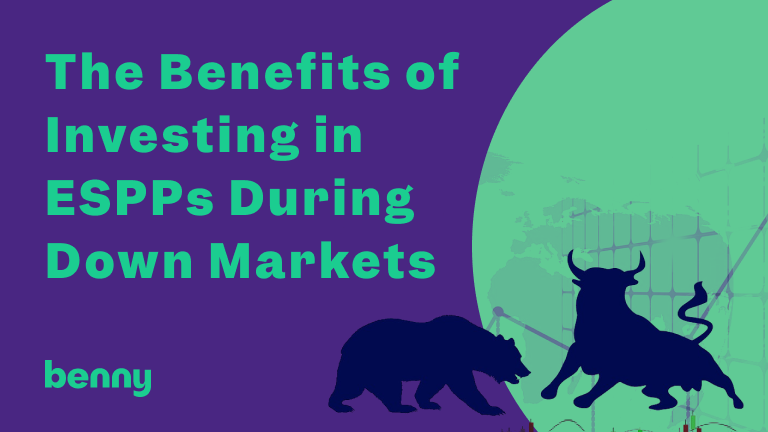An employee stock purchase plan (ESPP) is a great way to invest in your future and build wealth. As an employer-provided benefit, they offer you the chance to buy a company’s stock at a discounted price. Participating in an ESPP might seem like a no-brainer if you work for a company that has one – but what if there’s been a downturn in the market? In this article, we’ll explore whether or not investing in an ESPP is wise during economic downturns.
Make More Money from your ESPP with Benny’s New Program
Benny 2.0 automatically manages your Employee Stock Purchase Plan (ESPP) to make you more money without disrupting your take-home pay.
How Employee Stock Purchase Plans Work
Here’s what you need to know about ESPPs:
- Each time you purchase stock, you’ll get a discount on the stock-purchase price, typically up to 15%.
- You make after-tax contributions from your pay, and it will be deducted from each paycheck.
- There will be a set offering period when payroll deductions occur – for example, every quarter or six months.
- You purchase stock on a set purchase date that uses the accumulated deductions.
Why There’s Less Risk When Investing With An ESPP During A Downturn
1. Protection From the Stock Price Movements
If the share price of your company drops during the ESPP period, you’re protected.
Let’s say that during the six-month participation period you’ve contributed a total of $4,500 to your ESPP.
While your contributions are accumulating the share price for your company drops from $100 to $50. The volatility in the share price doesn’t really matter since instead of the 53 shares you would have received with the original stock price at $100 you’ll receive 106 shares for the new stock price at $50. The value of the shares received would remain the same during the six-month period when you were participating in the ESPP.
| Scenario | Stock Price as of Jan 1 | Stock Price as of June 30 | ESPP Discount | Contribution Amount | Shares Purchased | Value of Shares |
| Flat Stock Price | $100 | $100 | 15% | $4,500 | 53 | $5,300 |
| Decreasing Stock Price | $100 | $50 | 15% | $4,500 | 106 | $5,300 |
2. Lookback Provisions
Some ESPPs have a lookback provision for calculating the purchase price. A lookback provision is a really helpful feature that will base the purchase price for calculating the discount on the stock price either at the beginning of the offering period or at the end of the purchase period, whichever is lower. This means that if you buy at the beginning of an offering period and decide to sell at the end of it, you’ll get some extra value out of your stock—even though it’s already been discounted!
| Scenario | Stock Price as of Jan 1 | Stock Price as of June 30 | ESPP Discount | Contribution Amount | Shares Purchased | Value of Shares |
| Lookback | $100 | $115 | 15% | $4,500 | 53 | $6,095 |
Investing In the Open Market During A Downturn
If you buy shares without an ESPP on the open market, when stock prices decrease, the total value of an investment drops, too. To illustrate this point, let’s say you invested the same $4,500 amount in a company’s stock on January 1, and the stock price decreased from $100 to $50 over the course of six months while you held the stock. The value of the shares you have at the end of the six months would have decreased by $2,250.
| Scenario | Stock Price as of Jan 1 | Stock Price as of June 30 | ESPP Discount | Contribution Amount | Shares Purchased | Value of Shares |
| Open Market | $100 | $50 | N/A | $4,500 | 45 | $2,250 |
If you want to calculate how much money you lost on this investment, you can use a percentage change formula. The percentage change is calculated by subtracting the starting value from the ending value and dividing it by the starting value. In this case, we would subtract $100 – $50 = 50 and then divide 50 by 100: 50 / 100 = 0.5 or 50%.
You Should Take Advantage of an ESPP During a Downturn
Investing in your company’s stock through an ESPP is a great way to get the benefits of owning stock at a lower price and with fewer risks than if you purchased the shares on the open market.
With an ESPP, instead of paying cash for the stock, you purchase it using “discounted” dollars – meaning that you’re buying shares at a price lower than what they would be worth if they were sold on the open market. Because of this discount, there’s less risk involved when investing in your company’s stock during a downturn in its share price.
Make More Money from your ESPP with Benny’s New Program
Benny 2.0 automatically manages your Employee Stock Purchase Plan (ESPP) to make you more money without disrupting your take-home pay.
